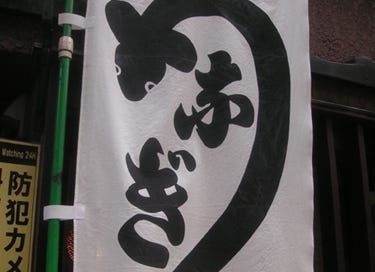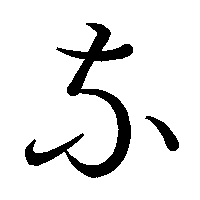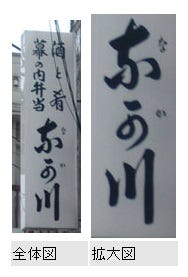Hey, what's that kana?
If you wander around Japan long enough you may have encountered this kana:
That’s right. You saw it on the signs out in front of unagi (grilled eel) shops, like this:
It sort of looks like ふ/fu. But actually it’s an old kana for na. These are the kanas called 変体仮名, or hentai-gana, variant-form kana. Like the kana we know and love, they are derived from cursive calligraphic (草書) forms (くずし字 or kuzushi-ji, “abbreviated characters”) of various kanji, in this case 奈, which happens to also be the origin of な.
More hentai-gana
In the ancient town of Kamakura, there's a great seafood restaurant on Komachi-dori, the cute little street that goes from the station up to the Tsurugaoka Hachiman-gu shrine, named Nakagawa, which uses this character. They also use a kuzushiji (cursive version) of 可 for the ka.
Modern-day Japanese are lucky to be able to read more than one or two of these archaic forms, the ones that have survived in forms like that used in signs in front of soba shops, for the ba in soba, this one also from Kamakura:
Here the そ (so) is from 楚, and the ば (ba) is from 者. Sometimes the ba looks much closer to む, with a loop on the left side and curving up more at the end, but it’s completely different. Question of the day: why is the 生 character here read き/ki? And what does ki-soba mean anyway?
Other variant kana you may encounter are the し (shi) which is the middle character in the name of the bar below. It is a cursive version of 志. The first character, い (i), is also cursive; it’s a different way of writing 以, the same character that い comes from.
Origins
We sometimes imagine that kana have always existed in the form we know them, ever since the days of the Manyoshu. In actuality, there were many kana-like forms for each sound—several dozen in some cases—that were used interchangeably. Often they derived from different characters, but like な and い some came from the same character but different styles of cursive writing. For example, here is a whole bunch of na kana, showing the characters each was derived from:
Some of the variant kana, such as the one below, derived from 等, could be used for two sounds, in this case both ra and to.
The current set of hiragana, it turns out, were not even standardized as they are used today until the beginning of the 20th century.
The above is a screen shot from Microsoft Word with the IPA MJ Mincho font installed. That font, and several others which are unlikely to be installed on your computer, can render the variant-form kana, which were added to Unicode in version 10.0 in the “kana supplement block”. For example, the na in unagi is HENTAIGANA LETTER NA‐4, found at code point 1B082.
There are also variant forms of katakana, but only a couple.










